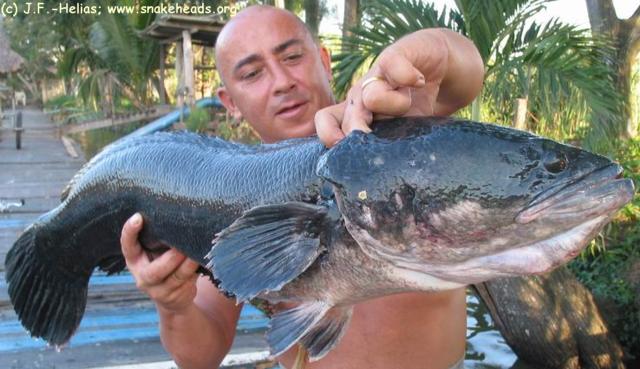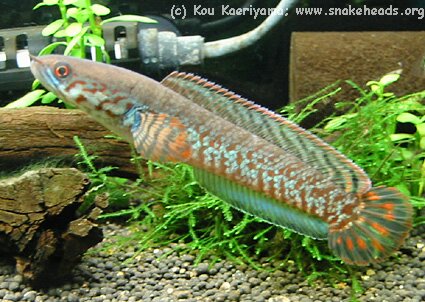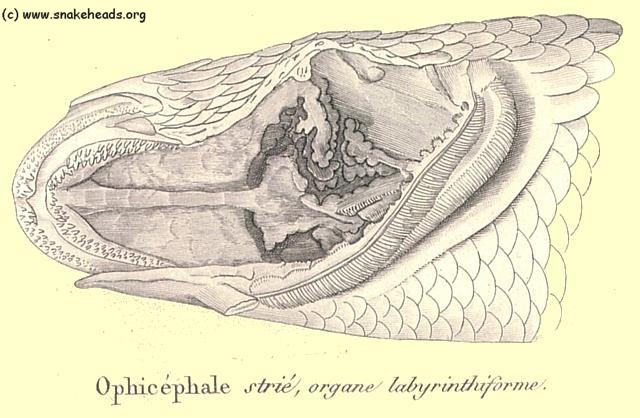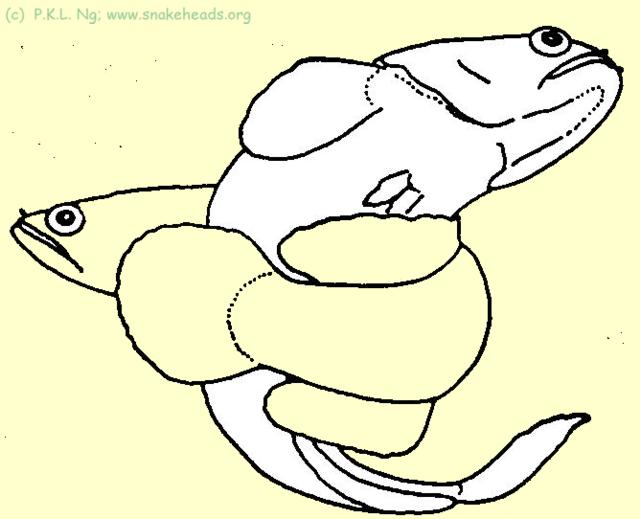
Amongst all the predatory fish that are more or less often kept in the aquarium, snakeheads have the worst and most undeserved reputation.
An often used quote is: «snakeheads are not fish for the comunity aquarium» . With this attitude, generations of aquarist have been preventing the snakehead from taking his rightfull place in the aquaristic hobby for several decades now. The reasons are obvious. Most species of snakeheads will grow to enormous proportions. For example the Northern snakehead, Channa argus , will reach about 80cm (33") and isn't really that big then. Some snakeheads can a reach total lenght of 1.2 m (4') and are real heavyweights at around 10 kg (22 pounds).
 | This C. micropeltes can hardly be called an aquarium fish. At least for at home. This fish weights 10 kg and is caught in Thailand. Now one easily understands why this fish is commonly called «Giant snakehead». |
Occassionally we can see juvenile snakeheads in the aquatic trade but sales are not very high. Because of the striking colouration there is always a small group of specialists that will house the fish in a adequate sized tank. There the fish will grow into mostly colourless «monsters». this is more of a writen joke then a fact, as this quote does not reflect the true character of these wonderful fish. Nevertheless the gigantic size and the ferocious appetite of the fish are the cause that snakeheads are only short guests in most aquariums, but lets put the public opinion aside, because snakeheads are in fact recommendable aquarium fish. The reason is that amongst the many species of snakehead, we can find fish with a total lenght of 20 to 35 cm (8 to 14") which are easily kept in a home aquarium.
Snakeheads are widely distributed in tropical asia. About 25 species are known of which some are rare and not often caught. Just as diverse as the fish, are the natural environment snakeheads call their home. Snakeheads live in all sorts of water, from fast flowing mountain creeks, river systems and water canals to rice fields as well as standing waters and small ponds. Besides Asia, snakeheads are found in some regions of africa but these are all characterised by a large bodysize.
There are 3 relatively well known species amongst the smaller species of snakehead. One of them, Channa bleheri , was only discovered in 1991 in Assam, Northern India. Another is Channa orientalis from Sri lanka which is often confused with Channa gachua Channa gachua can be found in India up to Myanmar, Pakistan, as well as Thailand, Malaysia and Veitnam. Even on the island of Bali are populations of Channa gachua . Both Channa are easily distinguished by the ventral fins which C. orientalis does not posses. All 3 snakeheads will reach a total length of 20 cm (8"). This means it is possible to keep them with other fish providing they can not be eaten by the snakeheads.
 | One of the most colorfull dwarf snakeheads: Channa bleheri |
Snakeheads belong to the group of labyrinth fish. This group of fish has an accessory breathing organ which enables them to breathe atmospheric air. This organ is a chamber above the gills that can be filled with air. Inside the chamber is a membrane covered in a mucus whose function can be compared to a lung.
 | This is one of the oldest drawings of the suprabranchial organ by Cuvier (1832). For this Channidae are well known in Ichthyology |
Depending on how many snakeheads are to be kept, the smaller species can be housed in a 100-200ltr tank. Ideal, would be a pair in a 100 ltr tank. Sadly it is not easy to sex snakeheads and even if a pair has found itself breeding, they still need a portion of good luck. Occasionly the fish will fight amongst each other and show a lot of aggression but this does not give any conclusions towards the sex of the fish.
It is important to cover the top of the tank well to prevent the snakeheads from jumping out of the tank. It is also essential to filter the water as the always hungry fish produce a lot of waste with their very high metabolism and will pollute the water very quickly. Even so snakeheads are very hardy and undemanding in their water requierments. A regular weater change is needed to keep the fish succesfull in the long run. Cover and hiding places should be provided to give the fish the most natural environment possible. This can consist of coconut shells, bogwood and dense plantcover. To make sure that the plants will not be uprooted by the snakeheads the plants should be properly rooted or have stones placed round the bottom of the plant for added protection. Many snakehead friends also add bioleafs or beechleaf to the tank which is beneficial to the snakeheads.
In one particular point snakeheads are no different from other predatory fish. we can not feed them primarily on industrial manufactured fishfoods. Snakeheads need to have a diet of fresh animal foods which should consist primarily of fish. Earthworms and mealworm are also foods snakeheads find hard to resist. Channas snap after everything that moves even if it doesn't fit in the mouth. This is how they learn what to eat and what not to eat, and what food should be avoided. Depending on the size of the fish, insect larve and bloodworm are also good foods, as is any form of frozen fish food.
If snakeheads are kept with other fish from a very young age, they can be very sociable, for a snakehead. Nevertheless, when they are adults snakeheads will bite every new fish, even if its too big to eat until they have learned the fish is not prey. Larger fish, like catfish are perfect tankmates for snakeheads, where as any fish with vail tails will cause prob- lems. Permanently attacked fish will need to be removed from the tank.
Most aquarists will breed snakeheads through pure coincidence as it is really difficult to find a harmonic breeding pair. As mentioned before there are no big differences between make and females. With fish of the same age the male will always be larger then the smaller females. Specialists can recognise the female because of its bigger belly, before spawning. During the breeding period the pair seem to be more at peace with each other. 1 Zugleich sucht das Männchen einen Laichplatz aus.
 | Schematic drawing of a mating couple of C. gachua . |
1 Judging on the grounds of our snakeheads.org literature data base , we have not found a single proof for this claim - how good are we in searching ? ;-) There are only a few species showing a clearer sexual dimorphism. But size has never been one. The best sign is the point of time when a couple has found themselves from a group of adolescent (!) fishes: that couple remains together permanently and the female tries to displace the rest of their kind from the spawning site which the male has found. It is the female which is in the defending role of the couple. The male takes over mouthbreeding and afterwards the care of the hatchlings. So, it would really make no sense, that the female takes over the care of the hatchlings! Are you in the lucky situation to choose channa from stuffed channa tank, take yourself time to watch them for a while. Depending on their age, one might be able to recognize a couple already. Dwarf snakeheads are sexually mature when they have reached a size of 12 to 15 cm which is equal to an age of one year. In the meantime it is proven that most dwarf snakeheads do eggfeeding. Of these no case is known where the female part had taken over the care of the hatchlings. [snakeheads.org] Back
2 This form of spawning is true until now for all but one dwarf Channa species. Channa bleheri is the exception. The breeding of this speciescan be read in this article . [Ulrich for snakeheads.org] Back
This text is an English translation of an article Schlangenkopffische sind doch Aquarienfische! Thankyou Ulrich Alsfasser for your translation of the text for snakeheads.org. You are the kind of guy we need more at snakeheads.org!! The German text was originally published in: Aquarium live, Juni/Juli 2003 , Nr. 3 pp. 62-65 . The author has granted snakeheads.org the right to publish it on the org's site. The copyright of text and the photos is still with the author/photographers in full amount.
| © 2001 - 2003 snakeheads.org | HOME of this page |